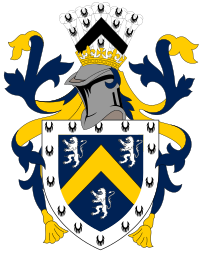| Hatfield College | ||||||||||||||||||||||
|---|---|---|---|---|---|---|---|---|---|---|---|---|---|---|---|---|---|---|---|---|---|---|
| University of Durham | ||||||||||||||||||||||
 | ||||||||||||||||||||||
 Arms of Hatfield College Arms: Azure a Chevron Or between three Lions rampant Argent a Bordure Ermine | ||||||||||||||||||||||
| Location | North Bailey, Durham, DH1 3RQ | |||||||||||||||||||||
| Coordinates | 54°46′28″N 1°34′27″W / 54.7744°N 1.5741°W | |||||||||||||||||||||
| Latin name | Collegium Hatfeldiensis | |||||||||||||||||||||
| Motto | Latin: Vel Primus Vel Cum Primis | |||||||||||||||||||||
| Motto in English | Either the first or with the first or colloquially, Second to None. | |||||||||||||||||||||
| Established | 1846 | |||||||||||||||||||||
| Named after | Thomas Hatfield | |||||||||||||||||||||
| Master | Ann MacLarnon (2017–) | |||||||||||||||||||||
| Chaplain | The Rev. Dr Julia Candy | |||||||||||||||||||||
| Undergraduates | 1010 (2017/18)[1] | |||||||||||||||||||||
| Postgraduates | 260 (2017/18)[1] | |||||||||||||||||||||
| Website | dur | |||||||||||||||||||||
| Map | ||||||||||||||||||||||
| Part of | Durham Castle and Cathedral | |||||||||||||||||||||
| Criteria | Cultural: ii, iv, vi | |||||||||||||||||||||
| Reference | 370 | |||||||||||||||||||||
| Inscription | 1986 (10th Session) | |||||||||||||||||||||
Hatfield College is one of the constituent colleges of Durham University in England. It occupies a city centre site above the River Wear on the World Heritage Site peninsula, lying adjacent to North Bailey and only a short distance from Durham Cathedral. Taking its name from a medieval Prince-Bishop of Durham, the college was founded in 1846 as Bishop Hatfield's Hall by David Melville, a former Oxford don.
Melville disliked the 'rich living' of patrician undergraduates at University College, and hoped to nurture a collegiate experience that would be affordable to those of limited means; and in which the students and staff were to be regarded as part of a single community. In line with his ambitions, the college pioneered the concept of catered residences for students, where all meals were taken in the hall, and occupants charged fixed prices for board and lodgings — this system became the norm for Durham colleges, and later on at Oxford and Cambridge, before spreading worldwide.
As the 20th century progressed, Hatfield was increasingly characterised by its irreverent atmosphere among undergraduates, reputation for academic indifference, sporting achievement — especially in rugby — and possessing a high intake of students from English public schools. College administration, on the other hand, preferred to highlight the willingness of students to get involved in a wide variety of university activities; and argued that 'Hatfield man', contrary to his reactionary image, had often been at the forefront of significant reform on campus.
College architecture is an eclectic blend of buildings from a variety of styles and periods. The sloping main courtyard contains an eighteenth-century dining hall, the restrained Jacobethan Melville Building (designed by Anthony Salvin), a Victorian Gothic chapel, and the 'inoffensive neo-Georgian' C Stairs. The trend for revivalist and traditional buildings was disposed of with the modern Jevons Building, located in the college's second courtyard, which interprets older forms in a more 'contemporary' manner.
After many decades as a single-sex institution, the first female undergraduates were formally admitted in Michaelmas term 1988.
- ^ a b "Term-Time Accommodation Stats" (PDF). Student Registry. Archived (PDF) from the original on 8 October 2019. Retrieved 30 March 2018.
